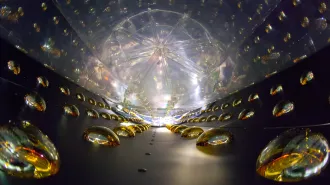A simulation of the early universe using string theory may explain why space has three observable spatial dimensions instead of nine.
The leading mathematical explanation of physics goes beyond modern particle theory by positing tiny bits of vibrating string as the fundamental basis of matter and forces. String theory also requires that the universe have six or more spatial dimensions in addition to the ones observed in everyday life. Explaining how those extra dimensions are hidden is a central challenge for string theorists.
“This new paper demonstrates, for the first time, that our 3-D space appears naturally … from the 9-D space that string theory originally has,” says Jun Nishimura of the High Energy Accelerator Research Organization in Tsukuba, Japan. He and his colleagues will publish their findings in an upcoming issue of Physical Review Letters.
In the simulation, the universe starts off as a tiny blob of strings that is symmetric in nine different dimensions. As the strings interact, a random energy fluctuation — provided by the quantum laws that govern these small scales — breaks the symmetry. Three dimensions balloon outward, leaving the other six stunted at a billionth of a trillionth of a trillionth of a centimeter, far too small to be detected.
Applying string theory to the beginning of the universe in this way has long proven difficult. That’s because the math included in traditional versions of the theory can be solved only when strings interact weakly at low temperatures, not in the seething maelstrom that existed moments after the Big Bang.
To tackle the extreme energies of the Big Bang, Nishimura and his team had to recast one version of string theory, called IIB, as grids of equations that could be fed into a supercomputer. Limited by the power of this computer, the researchers could track the interactions of no more than 32 strings for the first split second of history.
For some physicists, this way of approximating string theory is too oversimplified to be believable. “Frameworks like the one they’re using … lack a lot of other stuff that goes into trying to make a realistic model,” says Shamit Kachru, a theoretical physicist at Stanford University.
To prove the usefulness of the new approach, Nishimura’s team will need to study times much later in the universe’s history, comparing their results against real observations of how matter is distributed across the universe.







